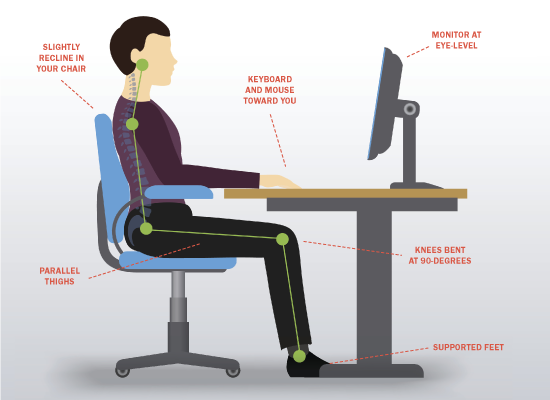
Over my career I have conducted ergonomics assessments of tens of thousands of workstations, processes, and people, including in the office environment. I have worked with clients in mines 900-feet below New Mexico, with massive fulfillment centers across the US, completed overnight assessments for transportation companies in the dead of winter in Minnesota, and assisted clients in Europe, Asia, Australia, North America and the Caribbean.
But regardless of where you work, or what you do, good work (and workstation) design is critical not only to your comfort, well-being, and safety, but also to your productivity and the quality of your work—as well as the profitability of your company.
The sudden move of millions of formerly traditional “office-based” employees to work-from-home during the 2020 COVID-19 pandemic shifted how millions of people work and go to school. Many people were suddenly thrown into unfamiliar territory along with their school- or preschool-aged children once the schools were all closed.
Good work posture is important, and this article will help you find a better position.
Both feet should be supported by the floor or a footrest. This helps you to sit back into the chair, and helps you look slimmer, because hunching forward displaces our internal organs from where they are supposed to be. If you frequently put your feet on the rungs of your chair, then something is wrong. Lower your chair until your feet are supported by the floor, then lower your work surface or keyboard tray until the keyboard is about elbow height. If you cannot lower your work surface, then place something under your feet, like a three-ring binder or a small box, until you feel yourself slightly tipping back into the chair.
Keep your knees bent about 90-degrees and adjust your chair so the front of the seat pan does not contact the back of your knees. Optimally there should be a two-finger gap between the front of the chair and the back of your knees. If the gap is too big, adjust the seat pan of the chair so it is “deeper.” If there is no gap, adjust the seat pan so the chair is less deep. Some people with shorter legs may need to adjust their chairs so the seat pans are less deep. If you do not have an adjustable chair, placed a pillow behind your back.
Your thighs should be about parallel with the floor. If your knees are too low relative to your hips, you will not have good support for your back. Not only will you constantly try to slide back into the chair, you will probably feel some extra lower back discomfort.
The best way to sit is to grasp the armrests with each hand and literally “slide your butt” down the backrest of the chair.
Slightly recline in your chair. If we lean forward, our food won’t digest as well, and our respiration efficiency is affected, meaning we won’t get an optimal amount of oxygen to our brains – which is important not only during conference calls, but all day.
Use the right casters/rollers for your chair. If your office has a carpet, a standard “carpet-appropriate” caster will suffice, but if your chair is on a hard surface such as wood or tile, then a softer caster is important. If the caster on a hard surface is not soft enough, then a chair can actually roll out from underneath a person while they attempt to sit down. Falls that lead to serious injuries (and fatalities) have occurred due to this happening.
Your keyboard and mouse must work for you, not the other way around. Why are you accommodating them and leaning towards them? If you frequently lean forward, then all of the weight of your upper body is now concentrated on your lower spine. If you lean back into the chair, then the backrest of the chair absorbs most of the weight of your upper body.
Bring the keyboard and mouse towards you, so you can work with your shoulders relaxed, elbows about 90-degrees, and your wrists straight.
Your head belongs on your shoulders and not in front, to the side, or in back of them. Nor does it belong in a basket. If your head is forward of your torso, then it causes your upper back to deform, and can cause spine discomfort across your shoulder blades. Sit back into the chair and bring your head back onto your shoulders. It is much more comfortable! Your ears, shoulders, and hips should be in relative alignment.
Keep the top of the monitor screen(s) about eye level. If you wear bifocal or progressive eyeglasses, lower the screen practically to the desk surface (that’s what I have, what I do, and what works for me!) If you have dual screens, they should be farther back on the desk, trusting you can read the screen, and the monitor you use more should be on the side of your stronger eye.
It is also important to consider children and pets while working from home. Keep cables and wires away from them, to avoid trips, falls, and damaged equipment. Also be sure to keep from overloading electrical circuits in older construction.
Other considerations include keeping scissors, staplers (especially electric ones) and paper shredders out of the reach of children. They can experience serious injuries, or worse.
Contact QP3 ErgoSystems’ team for help with video-based office workstation assessments.
When you are ready, we can arrange for our on-site, customized ergonomics training, COVID-19 audit and assessment services, or our onsite/ride-along transportation, warehouse and distribution-focused ergonomics services for even more help.
Feel free to call us at +1 (847) 921-3113, even just to chat… we’re all in this together!